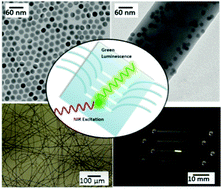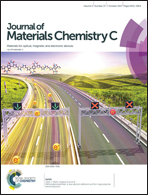Embedded nanolamps in electrospun nanofibers enabling online monitoring and ratiometric measurements†
Abstract
A multifunctional composite nanomaterial based on nanofiber embedding upconversion nanoparticles (UCNPs) is designed to address the common limitations of bioanalysis including the colloidal stability of nanoparticles, high background signals and small sample volumes. We fabricate thin and uniform electrospun polyvinylpyrrolidone (PVP) nanofibers with a diameter of 170 ± 80 nm, containing up to 254 ± 9 mg mL−1 of non-agglomerated UCNPs. On distributing these nanofibers in a microfluidic channel a 50-fold increase in luminescence over dispersed particles can be obtained. A versatile miniaturized platform is created to work with small sample volumes by transferring the upconversion nanofibers into microfluidic channels. Fast and reproducible analytical signal response to their environment is demonstrated by taking advantage of the isotope effect between H2O and D2O upon 980 nm excitation. Furthermore, relevance to analytical applications employing energy transfer was confirmed using the spectral overlap of the green UCNP emission with the absorption spectra of a dye. At minute optical path lengths (e.g. 50 μm) the luminescence properties of the UCNPs help in avoiding the most disturbing light scattering effects of the excitation source and channel geometries. This new nanomaterial platform enables rapid, simple and reliable online monitoring in microfluidic systems, medical applications (e.g. in-tissue, in vivo) and anti-counterfeiting in contrast to solution-based UCNP applications.



 Please wait while we load your content...
Please wait while we load your content...